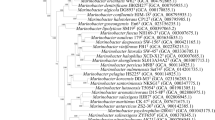Abstract
Samples from 27 natural and artificial aquatic environments were analyzed for the presence of rosette-forming bacteria by a combined cultivation and molecular biological approach. Rosette-forming bacteria developed in 20 enrichment cultures with ammonia-free medium under air. Three morphotypes could be distinguished. The most abundant type I resembled Nevskia ramosa and formed hydrophobic, flat, and dichotomously branching rosettes. Type II rosettes were three-dimensional and were observed in 10 enrichments, often together with those of type I. These rosettes were hydrophilic indicating life in the hyponeuston underneath the air–water interface. Rosettes of a third type consisted of hydrophilic slime stalks that were excreted at the cell poles and were observed in only one sample. Using fluorescence in situ hybridization (FISH) with the Nevskia-specific probes NEV177 and NEV656, the presence of Nevskia ramosa was demonstrated in exactly those samples that showed type I rosettes. In a series of most-probable-number experiments, during a calm and sunny weather period 430,000 Nevskia-like bacteria per mL were found in surface samples, while during rainy weather and within the water body the numbers were lower by several orders of magnitude. Five pure cultures isolated from various enrichments were characterized in detail. The two isolates forming type I rosettes were identified as Nevskia ramosa by 16S rDNA analysis. However, comparison by genomic fingerprinting (ERIC-PCR) revealed differences between the two isolates and previously characterized strains. The 16S rDNA of two isolates forming type II rosettes showed 97.6% similarity to that of Pseudomonas fluorescens. The closest relative of the isolate forming type III rosettes was Sphingomonas parapaucimobilis (96.4% sequence similarity of the 16S rRNA sequence). All isolates grew homogeneously submersed if ammonia was added to the medium. Our results indicate that Nevskia ramosa is a widely distributed epineustonic bacterium, which can specifically be deleted by its flat and hydrophobic rosettes on ammonia-free media.






Similar content being viewed by others
References
H-D Babenzien (1965) ArticleTitleÜber Vorkommen und Kultur von Nevskia ramosa. Zentralbl Bakteriol Parasitenkd Infektionskr Hyg Abt 1 IssueIDSuppl 1 111–116
H-D Babenzien (1967) ArticleTitleZur Biologie von Nevskia ramosa. Z Allg Mikrobiol 7 89–96 Occurrence Handle1:STN:280:CCeA1Mfls1Q%3D Occurrence Handle5598146
H-D Babenzien W Schwartz (1970) ArticleTitleStudien zur Mikrobiologie des Neustons. Limnologica 7 247–272
H-D Babenzien P Hirsch (1974) Genus Nevskia. RE Buchanan NE Gibbons (Eds) Bergey’s Manual of Determinative Bacteriology. EditionNumber8th ed Williams & Wilkins Baltimore 161–162
H-D Babenzien H Cypionka (2003) Genus Nevskia Famintzin 1892, 484AL. GM Garrity (Eds) Bergey’s Manual of Systematic Bacteriology, Vol 2. Williams and Wilkins Baltimore
WC Duncan-Hewitt Z Policova P Cheng EI Varga-Butler AW Neumann (1989) ArticleTitleSemiautomatic measurement of contact angles on cell layers by a modified axisymmetric drop shape analysis. Colloids Surf 42 391–403
A Famintzin (1892) ArticleTitleEine neue Bakterienform: Nevskia ramosa. Bull Acad Imp Sci St Petersburg, New Ser 234 481–468
WC Fehon JD Oliver (1979) ArticleTitleTaxonomy and distribution of surface microlayer bacteria from two estuarine sites. Estuaries 2 194–197
L Geitler (1942) ArticleTitleZur Kenntnis der Bewohner des Oberflächenhäutchens einheimischer Gewässer. Biol General 16 452–473
FO Glöckner HD Babenzien R Amann (1998) ArticleTitlePhylogeny and identification in situ of Nevskia ramosa. Appl Environ Microbiol 64 1895–1901 Occurrence Handle9572969
P Hirsch (1981) The genus Nevskia. MP Starr H Stolp HG Trüper A Balows HG Schlegel (Eds) The Prokaryotes. A Handbook on habitats, Isolation, and Identification of Bacterica Springer-Verlag Berlin 521–523
P Hirsch (1999) ArticleTitleDiversity of Lake Plußsee bacteria—some old-fashioned morphological and enrichment culture studies revealing not yet culturable microbial forms. Arch Hydrobiol Adv Limnol 54 213–235
JS Maki (1994) The air–water interface as an extreme environment. TE Ford (Eds) Aquatic Microbiology. Blackwell Scientific Oxford 409–439
Naumann (1915) ArticleTitleQuantitative Untersuchungen über die Organismenformation der Wasseroberfläche. II. Über das Neuston des Süßwassers. Biol Zbl 37 98–106
B Norkrans (1980) ArticleTitleSurface microplayers in aquatic environments. Adv Microbiol Ecol 4 51–85 Occurrence Handle1:CAS:528:DyaL3MXktlOnsw%3D%3D
Romeis, B (1989) In: Bock, P (ed) Mikroskopische Technik, 17th ed., Urban & Schwarzenberg, München, p 522
F Ruttner (1952) Grundriß der Limnologie, 2nd ed. Walter de Gruyter & Co Berlin
H Stürmeyer J Overmann HD Babenzien H Cypionka (1998) ArticleTitleEcophysiological and phylogenetic studies of Nevskia ramosa in pure culture. Appl Environ Microbiol 64 1890–1894 Occurrence Handle9572968
Acknowledgments
We thank Josef Gödde, Frank Oliver Glöckner, Jörg Overmann, and Rudolf Amann for providing samples and valuable support during the molecular biological experiments.
Author information
Authors and Affiliations
Corresponding author
Rights and permissions
About this article
Cite this article
Pladdies, T., Babenzien, HD. & Cypionka, H. Distribution of Nevskia ramosa and Other Rosette-Forming Neustonic Bacteria. Microb Ecol 47, 218–223 (2004). https://doi.org/10.1007/s00248-003-1070-3
Received:
Accepted:
Published:
Issue Date:
DOI: https://doi.org/10.1007/s00248-003-1070-3




